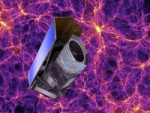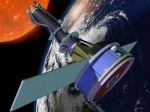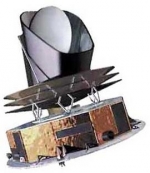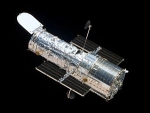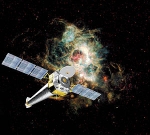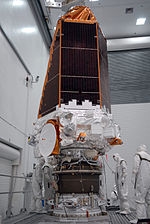Displaying items by tag: space observatory
Suzaku satellite
Suzaku (formerly ASTRO-EII) is a Japanese X-ray astronomy satellite.
It was launched on 10 July 2005 aboard the M-V-6 rocket. The project was renamed Suzaku after its successful launch after the mythical Vermilion bird of the South.
Suzaku is carrying high spectroscopic resolution, very wide energy band instruments for detecting signals ranging from soft X-rays up to gamma-rays (0.3–600 keV). High resolution spectroscopy and wide-band are essential factors to physically investigate high energy astronomical phenomena, such as black holes and supernovae. One such feature, the broad iron K line, may be key to more direct imaging of black holes.
Just weeks after launch, on 29 July 2005 the first of series of cooling system malfunctions occurred, that ultimately on 8 August 2005 caused the entire reservoir of liquid helium to boil off into space. This effectively shut down the XRS which is the spacecraft's primary instrument. The two other instruments, XIS and HXD, were unaffected by the malfunction, and there are plans (Oct. 2013) to integrate another XRS into the proposed NeXT X-ray observation satellite planned for launch in 2014.
Compton Gamma Ray Observatory (CGRO)
The Compton Gamma Ray Observatory (CGRO) was a space observatory detecting light from 20 KeV to 30 GeV in Earth orbit from 1991 to 2000.
It featured four main telescopes in one spacecraft covering x-rays and gamma-rays, including various specialized sub-instruments and detectors. Following 14 years of effort, the observatory was launched on the Space Shuttle Atlantis, mission STS-37, on 5 April 1991 and operated until its deorbit on 4 June 2000. It was deployed in low earth orbit at 450 km to avoid the Van Allen radiation belt.
Euclid satellite
Euclid is an ESA mission selected for launch in 2019 in the Cosmic Vision 2015-2025 programme. The main goal of Euclid is to understand the origin of the accelerating expansion of the Universe. To achieve this, it is proposed to build a satellite equipped with a 1.2 m telescope and three imaging and spectroscopic instruments working in the visible and near-infrared wavelength domains.
The primary goall is to understand the nature of dark energy and dark matter by accurate measurement of the accelerated expansion of the Universe through different independent methods.
IRIS spacecraft
The Interface Region Imaging Spectrograph (or IRIS) is a space probe, planned by NASA, to observe the Sun.
It is a NASA Small Explorer program mission to investigate the physical conditions of the solar limb, particularly the chromosphere of the Sun.
IRIS will observe how solar material moves, gathers energy, and heats up as it travels through a little-understood region in the sun's lower atmosphere. Tracking how material and energy move through this region is a crucial part of understanding the dynamics of the sun.
NASA announced on June 19, 2009 that IRIS was selected from six small explorer mission candidates.
Planck Space Observatory
Planck — a Cosmic Microwave Background explorer, after COBE & WMAP. launched in may 2009.
Planck is a space observatory of the European Space Agency (ESA) and designed to observe the anisotropies of the cosmic microwave background (CMB) over the entire sky, at a high sensitivity and angular resolution. Planck was built in the Cannes Mandelieu Space Center by Thales Alenia Space and created as the third Medium-Sized Mission (M3) of the European Space Agency's Horizon 2000 Scientific Programme. The project, initially called COBRAS/SAMBA, is named in honour of the German physicist Max Planck (1858–1947), who won the Nobel Prize for Physics in 1918.
Planck was launched in May 2009, reaching the Earth/Sun's L2 Lagrangian point in July, and by February 2010 had successfully started a second all-sky survey. Preliminary data from these surveys have been released, and results are said to indicate that the data quality is excellent. Planck is expected to yield definitive data on a number of astronomical issues by 2012. The mission will complement and improve upon observations made by the NASA Wilkinson Microwave Anisotropy Probe (WMAP), which has measured the anisotropies at larger angular scales and lower sensitivity than Planck. Planck will provide a major source of information relevant to several cosmological and astrophysical issues, such as testing theories of the early universe and the origin of cosmic structure.
The mission has a wide variety of scientific aims, including:
- High resolution detections of both the total intensity and polarization of the primordial CMB anisotropies
- Creation of a catalogue of galaxy clusters through the Sunyaev-Zel'dovich effect
- Observations of the gravitational lensing of the CMB, as well as the integrated Sachs–Wolfe effect
- Observations of bright extragalactic radio (active galactic nuclei) and infrared (dusty galaxy) sources
- Observations of the Milky Way, including the local interstellar medium, distributed synchrotron emission and measurements of the galactic magnetic field.
- Studies of the local Solar System, including planets, asteroids, comets and the zodiacal light.
Hubble Space Telescope
The Hubble Space Telescope (HST) is a space telescope that was carried into orbit by a Space Shuttle in 1990 and remains in operation. A 2.4 meter (7.9 ft) aperture telescope in low Earth orbit, Hubble's four main instruments observe in the near ultraviolet, visible, and near infrared. The telescope is named after the astronomer Edwin Hubble.
Hubble's orbit outside the distortion of Earth's atmosphere allows it to take extremely sharp images with almost no background light. Hubble's Ultra-Deep Field image, for instance, is the most detailed visible-light image ever made of the universe's most distant objects. Many Hubble observations have led to breakthroughs in astrophysics, such as accurately determining the rate of expansion of the universe.
Although not the first space telescope, Hubble is one of the largest and most versatile, and is well known as both a vital research tool and a public relations boon for astronomy. The HST was built by the United States space agency NASA, with contributions from the European Space Agency, and is operated by the Space Telescope Science Institute. The HST is one of NASA's Great Observatories, along with the Compton Gamma Ray Observatory, the Chandra X-ray Observatory, and the Spitzer Space Telescope.
Space telescopes were proposed as early as 1923. Hubble was funded in the 1970s, with a proposed launch in 1983, but the project was beset by technical delays, budget problems, and the Challenger disaster. When finally launched in 1990, scientists found that the main mirror had been ground incorrectly, significantly compromising the telescope's capabilities. However, after a servicing mission in 1993, the telescope was restored to its intended quality.
Hubble is the only telescope designed to be serviced in space by astronauts. Between 1993 and 2002, four missions repaired, upgraded, and replaced systems on the telescope, but a fifth mission was canceled on safety grounds following the Columbia disaster. However, after spirited public discussion, NASA administrator Mike Griffin approved one final servicing mission, completed in 2009. The telescope is now expected to function until at least 2014. Its scientific successor, the James Webb Space Telescope (JWST), is to be launched in 2018 or possibly later.
NuSTAR Telescope
Nuclear Spectroscopic Telescope Array (NuSTAR) is a planned space-based X-ray telescope that will use a Wolter telescope to focus high energy X-rays at 5 to 80 keV from astrophysical sources, especially for nuclear spectroscopy. It is the eleventh mission of the NASA Small Explorer satellite program (SMEX-11) and the first space-based direct-imaging X-ray telescope at energies beyond those of the Chandra X-ray Observatory and XMM-Newton.
Mission launch is scheduled for 21 March 2012.
Its primary scientific goals are to conduct a deep survey for black holes a billion times more massive than our sun, understand how particles are accelerated to within a fraction of a percent of the speed of light in active galaxies, and understand how the elements are created in the explosions of massive stars by imaging the remains, which are called supernova remnants.
NuSTAR employs two grazing incidence focusing optics each of which consists of 133 concentric shells. The optics used were coated by DTU Space in Copenhagen and assembled at the Nevis Laboratories of Columbia University.
Partners:
The principal investigator is the California Institute of Technology (Caltech). Other major partners include the Jet Propulsion Laboratory (JPL), University of California at Berkeley, Danish Technical University (DTU),Columbia University, Goddard Space Flight Center, Stanford University, University of California, Santa Cruz,Sonoma State University, Lawrence Livermore National Laboratory, and the Italian Space Agency (ASI). NuSTAR's major industrial partners include Orbital Sciences Corporation and ATK Space Systems-Goleta.
Chandra X-ray Observatory
The Chandra X-ray Observatory is a satellite launched on STS-93 by NASA on July 23, 1999. It was named in honor of Indian-American physicist Subrahmanyan Chandrasekharwho is known for determining the maximum mass for white dwarfs. "Chandra" also means "moon" or "luminous" in Sanskrit.
Chandra Observatory is the third of NASA's four Great Observatories. The first was Hubble Space Telescope; second the Compton Gamma Ray Observatory, launched in 1991; and last is the Spitzer Space Telescope. Prior to successful launch, the Chandra Observatory was known as AXAF, the Advanced X-ray Astrophysics Facility. AXAF was assembled and tested by TRW (now Northrop Grumman Aerospace Systems) in Redondo Beach,California. Chandra is sensitive to X-ray sources 100 times fainter than any previous X-ray telescope, due primarily to the high angular resolution of the Chandra mirrors.
Since the Earth's atmosphere absorbs the vast majority of X-rays, they are not detectable from Earth-based telescopes, requiring a space-based telescope to make these observations.
Kepler (mission & spacecraft)
The Kepler spacecraft is an American space observatory, the space-based portion of NASA's Kepler mission to discover Earth-like planets orbiting other stars. The spacecraft is named in honor of the 17th-century German astronomer Johannes Kepler. The spacecraft was launched on March 7, 2009, with a planned mission lifetime of at least 3.5 years.
The Kepler mission is "specifically designed to survey a portion of our region of theMilky Way galaxy to discover dozens of Earth-size planets in or near the habitable zone and determine how many of the billions of stars in our galaxy have such planets." Kepler's only instrument is a photometer that continuously monitors the brightness of over 145,000 main sequence stars in a fixed field of view. This data isanalyzed to detect periodic fluctuations that indicate the presence of extrasolar planets that are in the process of crossing the face of other stars.



